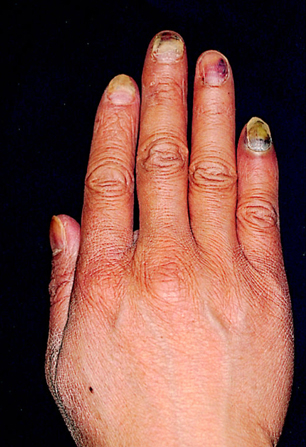Yonsei Med J.
2007 Feb;48(1):124-126. 10.3349/ymj.2007.48.1.124.
Docetaxel-Induced Onycholysis: The Role of Subungual Hemorrhage and Suppuration
- Affiliations
-
- 1Department of Dermatology, Yonsei University College of Medicine, Seoul, Korea. wlewderm@yumc.yonsei.ac.kr
- 2Department of Medical Oncology, Yonsei University College of Medicine, Seoul, Korea.
- KMID: 1093533
- DOI: http://doi.org/10.3349/ymj.2007.48.1.124
Abstract
- Nail changes are common side effects of taxane chemotherapeutic agents. Docetaxel (Taxotere(R)) is known to cause a great incidence of nail change. Various types of nail changes have previously been reported as a result of treatment with taxanes. We describe 2 cases of severe nail changes induced by docetaxel. The patients had previously been diagnosed with breast cancer and advanced gastric cancer, respectively. During the course of treatment with docetaxel, nail changes became apparent in both patients. Initially, they complained of nail bed purpura. Subungual hematomas with hemopurulent discharge were later observed in several fingers. Drainage of the hemopurulent material occurred spontaneously in our cases, leading to onycholysis. Following drainage, the pain in the nail with subungual hemoprulent material was relieved immediately and spontaneous healing of the patients' nails was noticed after few months. Subungual hemorrhage and suppuration therefore are considered causes of onycholysis and the pain in these patients. Although systemic or topical antibiotics were not used to treat these patients, antibiotics may be also worthwhile to hasten the drainage of the subungual hematomas and suppuration in patients for quick relief of pain.
Keyword
Figure
Reference
-
1. Chevallier B, Fumoleau P, Kerbrat P, Dieras V, Roche H, Krakowski I, et al. Docetaxel is a major cytotoxic drug for the treatment of advanced breast cancer: a phase II trial of the Clinical Screening Cooperative Group of the European Organization for Research and Treatment of Cancer. J Clin Oncol. 1995. 13:314–322.2. Francis P, Schneider J, Hann L, Balmaceda C, Barakat R, Phillips M, et al. Phase II trial of docetaxel in patients with platinum-refractory advanced ovarian cancer. J Clin Oncol. 1994. 12:2301–2308.3. Fossella FV, Lee JS, Murphy WK, Lippman SM, Calayag M, Pang A, et al. Phase II study of docetaxel for recurrent or metastatic non-small-cell lung cancer. J Clin Oncol. 1994. 12:1238–1244.4. Pavithran K, Doval DC. Nail changes due to docetaxel. Br J Dermatol. 2002. 146:709–710.5. Minisini AM, Tosti A, Sobrero AF, Mansutti M, Piraccini BM, Sacco C, et al. Taxane-induced nail changes: incidence, clinical presentation and outcome. Ann Oncol. 2003. 14:333–337.6. Correia O, Azevedo C, Pinto Ferreira E, Braga Cruz F, Polonia J. Nail changes secondary to docetaxel (Taxotere). Dermatology. 1999. 198:288–290.7. Rafi L, Friedrich M, Tilgen W, Reichrath J. Severe nail changes due to Docetaxel treatment. Eur J Dermatol. 2003. 13:610–611.8. Nicolopoulos J, Howard A. Docetaxel-induced nail dystrophy. Australas J Dermatol. 2002. 43:293–296.9. Flory SM, Solimando DA Jr, Webster GF, Dunton CJ, Neufeld JM, Haffey MB. Onycholysis associated with weekly administration of paclitaxel. Ann Pharmacother. 1999. 33:584–586.10. Vanhooteghem O, Andre J, Vindevoghel A, Vandenbossche L, Vandeveire A, Song M. Docetaxel-induced subungual hemorrhage. Dermatology. 1997. 194:419–420.11. Ghetti E, Piraccini BM, Tosti A. Onycholysis and subungual haemorrhages secondary to systemic chemotherapy (paclitaxel). J Eur Acad Dermatol Venereol. 2003. 17:459–460.12. Vanhooteghem O, Richert B, Vindevoghel A, Vandenbossche L, Vandeveire A, de la Brassinne M. Subungal abscesses: a new ungual side-effect related to docetaxel therapy. Br J Dermatol. 2000. 143:462–463.13. Wasner G, Hilpert F, Schattschneider J, Binder A, Pfisterer J, Baron R. Docetaxel-induced nail changes--a neurogenic mechanism: a case report. J Neurooncol. 2002. 58:167–174.14. Wasner G, Hilpert F, Baron R, Pfisterer J. Clinical picture: nail changes secondary to docetaxel. Lancet. 2001. 357:910.



